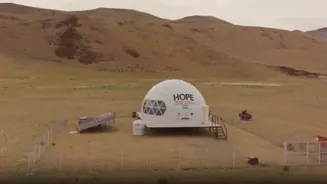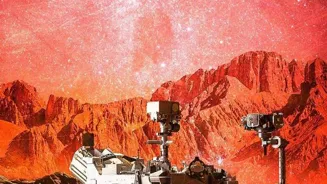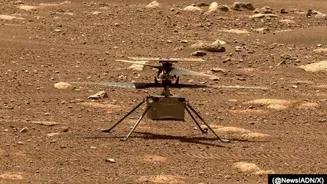The cold desert of Ladakh is now home to a unique facility that mimics what life could be like on the Moon or Mars.
In a significant step towards India’s human spaceflight goals, theIndian
Set up in the high-altitude Tso Kar valley, this 10-day mission, which began on August 1, is focused on people, testing how humans handle the physical and mental challenges they would likely face during a long space journey, such as a crewed mission to Mars.
So what exactly is inside the Hope simulator? And how could it shape the way India prepares for
Here’s a closer look.
What is Hope?
Hope has been set up in one of the most Mars-like environments on Earth, a high-altitude, cold desert in Ladakh located 4,530 metres above sea level.
According to a report by India Today, the Hope habitat is made up of two interconnected modules:
an 8-metre-wide living unit for the crew, and a 5-metre utility module that contains essential equipment and support systems.
Inside this compact and self-sustaining station,
The mission has been built and is being operated by Protoplanet, a Bengaluru-based startup. Backed by Isro's Human Spaceflight Centre, it also involves scientific contributions from IIT Bombay, IIT Hyderabad, IIST, and RGCB Trivandrum.
According to
Dr. V. Narayanan, Chairman, ISRO and Secretary, Department of Space, formally inaugurated ISRO’s high-altitude analog mission HOPE on 31st July 2025.
The mission is scheduled to be conducted from 1st to 10th August 2025 at Tso Kar, Ladakh (elevation: 4,530 metres).
Set in one of… pic.twitter.com/zMYeoBdUkT
— ISRO (@isro) August 1, 2025
“Hope is not just a test of endurance; it’s a critical proving ground for India’s future human space missions. The insights we gather here will directly impact how we train astronauts, design mission protocols, and develop sustainable spaceflight systems,” said Isro Chairman V Narayanan during the mission’s inauguration.
Also read: What we know about Vyommitra, the female humanoid
What will happen during Hope?
The 10-day mission is packed with carefully planned experiments and activities, all of which are being closely monitored by Isro scientists and mission control teams.
Some of the key areas being tested include:
-Monitoring physical health: Real-time monitoring of how the crew’s body responds to high altitude and low-oxygen conditions.
-Studying mental well-being: Analysis of stress levels, cognitive functioning, and
-Testing new tech: Field testing of advanced equipment like biomedical devices, prototype spacesuits, and communication tools under simulated Mars conditions.
-Running emergency drills: Simulations of possible mission crises, such as equipment failure or health emergencies, to test how well response protocols work in extreme environments.
"This is going to be a very major facility," Dr V Narayanan told NDTV. "It will be helping us in a big
Why was Ladakh chosen for Hope?
The Indian space agency chose Tso Kar Valley in Ladakh for a reason.
This high-altitude desert, sitting at 4,530 metres above sea level, offers some of the most Mars-like conditions on Earth. The thin air, low oxygen, extreme cold, high UV radiation, and rocky terrain closely resemble what astronauts would face on another planet.
In fact, Ladakh has already been used in previous smaller
Why Hope is significant
As India prepares for its ambitious human spaceflight roadmap, including the Gaganyaan mission, a space station by 2035and a crewed lunar landing by 2040, the Hope analogue mission
“This is a rehearsal for the future,” said Narayanan. “It is essential for our human space programme leading up to sending a human to the Moon.”
Hope gives Isro a rare chance to test out life-support systems, observe how crew members work and respond in isolation, and fine-tune mission procedures, all in a Mars-like setting without ever leaving Earth.
But the mission goes beyond just testing equipment. It’s also a strong statement of purpose. With Hope, India joins a small
With input from agencies
















